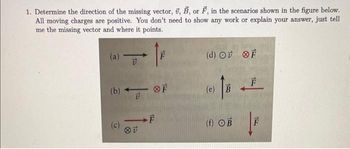Question

Transcribed Image Text:1. Determine the direction of the missing vector, U, B, or F, in the scenarios shown in the figure below.
All moving charges are positive. You don't need to show any work or explain your answer, just tell
me the missing vector and where it points.
(a)
15
(b) +
(c)
15
14
→F
F
8
15
(d) OF OF
150
(e) B
(f) OB
F
|
14
F
Expert Solution
This question has been solved!
Explore an expertly crafted, step-by-step solution for a thorough understanding of key concepts.
This is a popular solution
Trending nowThis is a popular solution!
Step by stepSolved in 3 steps

Knowledge Booster
Similar questions
- Question 14 of 35 A particle that carries a net charge of-41.8 uC is held in a constant electric field that is uniform over the entire region. The electric field vector is oriented 25.2° clockwise from the vertical axis, as shown in the figure. If the magnitude of the electric field is 4.32 N/C, how much work is done by the electric field as the particle is made to E move a distance of d = 0.556 m straight up? d. 25.2° work: J What is the potential difference AV between the particle's initial and final positions? AV =arrow_forwardCh 18 q3 In 1910 Rutherford performed a classic experiment in which he directed a beam of alpha particles at a thin gold foil. He unexpectedly observed a few of the particles scattered almost directly backward. This result was not consistent with then current models of atomic structure and led Rutherford to propose the existence of a very dense concentration of positive charge at the center of an atom—the atomic nucleus. The alpha particle has a charge of +2e and the gold nucleus a charge of +79e. Suppose that an alpha particle is initially a great distance from the gold, has a kinetic energy of 4.20 MeV (4.20 106 eV), and is headed directly at a gold nucleus. How close will the particle come to the center of the nucleus? Treat the nucleus and the alpha particle as point charges.arrow_forwardA uniform electric field with magnitude of 8.00 * 104 that is directed vertically upward has a m charge of 40.0 nC placed inside. What is the change in potential energy of moving the charge a. 0.65 m to the right b. 0.85 m vertically upward C. 0.40 m downward at an angle of 25° from the horizontalarrow_forward
- The three q1=q2=q3 = 14 μC charges came into the arrangement shown below from very far apart. q1 is located at (0.00, 5.2) cm, q2 is located at (0.00, -5.2) cm and q3 located at (13.26, 0.00) cm a) How much work must be done to move the three charges into the arrangement shown if they started very far apart? b) What is the work if the particle on the right, q3, with mass 49.5 g, is released from rest and allowed to move freely to point P, twice 13.26 distance, figure below? c) How fast, in m/s, is q3 moving when it has moved to point P, twice 13.26 distance? To continue, please submit the result of part (c) in units of m/s. Round your answer to 0 decimal places.arrow_forwardI need help with the first two parts of the question. Thanks!arrow_forwardQuestion 1 Consider two charges +q and +3q. There original distance is d. How much work is needed to bring +3q to a distance d/2? 1 W ext 4πεο O 3q^2 (1/d) -3q^2 (1/d) 3q (1/d) -3q (1/d)arrow_forward
arrow_back_ios
arrow_forward_ios